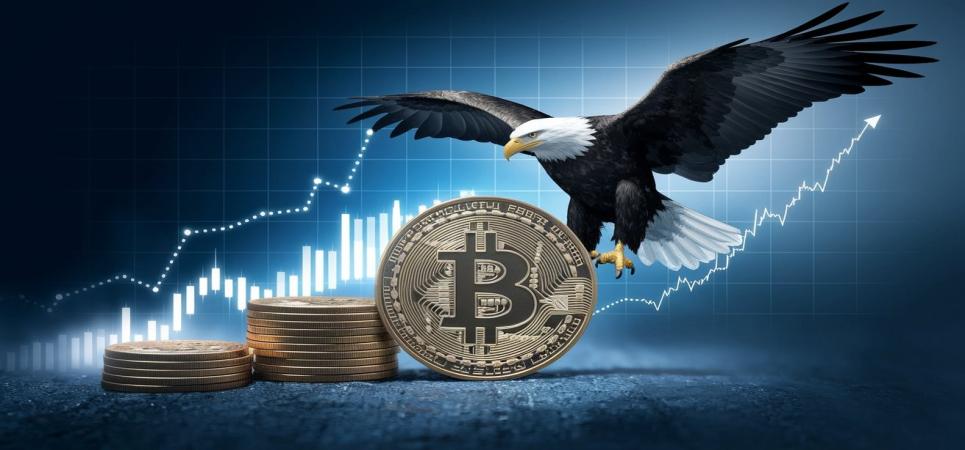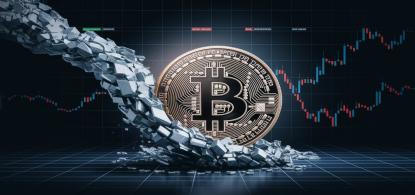
Bitcoin Price Surges As Federal Reserve Reveals Plans To Provide Liquidity If Necessary
Bitcoin Price Surges As Federal Reserve Reveals Plans To Provide Liquidity If Necessary
Summary
Bitcoin's price has increasingly become reliant on macroeconomic policy, particularly Federal Reserve policy. What the Fed does, such as injecting liquidity or cutting rates, is indicative of concerns about economic stability and thus tends to make investors cautious about conventional financial markets, and they seek alternate assets like Bitcoin, which they view as a hedge against currency devaluation and inflation. The fixed supply of bitcoins (there will ever only be 21 million of them) also shields Bitcoin from inflationary pressures brought on by central bank actions like quantitative easing, when money is printed to inject the economy.
As institutional investors have poured into the world of cryptocurrencies, Bitcoin has become increasingly linked to the traditional financial universe. It is no longer a standalone niche asset but more viewed as part of an overall investment portfolio. As the Fed announces something that devalues the U.S. dollar or increases inflation fears, Bitcoin picks up as investors seek safety and put their value there. This has led to huge price volatility because speculation in the markets is a significant reason why Bitcoin's price goes up or down following announcements by the Fed.
Market speculation also causes Bitcoin's price instability. Investors react to the latest news from the Fed instantaneously, and the majority place bets on what happens to the market. Thus, the price of Bitcoin can vary or crash after even minor policy shifts in the Fed. While Bitcoin is viewed as a potential hedge for times of uncertainty, its volatility means that it remains a high-risk investment.
Introduction
In the past days, the price of Bitcoin has surged noticeably, drawing the interest of investors and market watchers globally. A major reason for this surge is an official pronouncement made by the United States Federal Reserve recently. The Federal Reserve, or the Fed, said that it is ready to pump liquidity into the financial system if the necessity arises. This implies that the Fed is ready to inject money into the economy to stabilize banks and financial institutions during times of stress.
This has seen a wave of optimism in the crypto market, especially for Bitcoin. Investors view this move as a sign that the government is prepared to come in and support the economy when times get tough. This support will make more money within the economy that can water down the value of the U.S. dollar and encourage people to invest in alternative assets like gold and Bitcoin. Bitcoin, or "digital gold" as it is popularly referred to, is considered by many to be a safe repository for money when traditional markets become unstable.
In plain terms, when the Fed says that it will inject liquidity, it means that it will support banks and markets by making sure that there is enough cash available. This keeps financial panic at bay and makes sure that the economy is smooth. In the past, such actions by the Fed have led to rallies in equity markets and the price of Bitcoin. That is why this recent statement has created a buzz among crypto traders.
Another reason why Bitcoin is rising is that the masses are anticipating lower interest rates in the future. With lower interest rates, borrowing money is cheaper, and people will tend to invest in something such as Bitcoin. Now that the Fed has signaled that it's going to support the market, everybody is expecting interest rates to decrease any time now or at least to top out. That's another bullish indicator for Bitcoin.
Table of Contents:
-
Why did the price of Bitcoin suddenly surge following the Federal Reserve’s announcement?
-
Is the Federal Reserve’s plan to provide liquidity seen as a sign of potential economic instability?
-
Could the Fed’s willingness to inject liquidity boost investor confidence in cryptocurrencies like Bitcoin?
-
Does this move indicate that traditional financial systems are under pressure, prompting a shift toward Bitcoin?
-
How do investors perceive Bitcoin as a hedge against central bank policies like quantitative easing?
-
Is Bitcoin becoming more correlated with macroeconomic policy decisions than ever before?
-
Could the Fed’s intervention trigger a broader rally in digital assets and alternative investments?
-
What role does market speculation play in Bitcoin’s price volatility after Fed announcements?
-
Conclusion
-
Frequently Asked Questions (FAQ's)
Why did the price of Bitcoin suddenly surge following the Federal Reserve’s announcement?
The price of Bitcoin rapidly surged following the Federal Reserve announcement because the Fed said that it is willing to provide liquidity to the financial system if the need arises. That is language for the Fed to inject more money into the economy to ensure stability during hard times. When that happens, people are afraid that the value of such hard currencies as the U.S. dollar would decrease.
Thus, the majority of investors start investing in Bitcoin, which they feel is safer or a better store of value. Also, the announcement made individuals think that the Fed would lower the interest rates or not increase them further. Lower interest rates make it easier to borrow money and generally induce people to invest more in assets like Bitcoin. All these combined resulted in a sudden jump in the price of Bitcoin.
Is the Federal Reserve’s plan to provide liquidity seen as a sign of potential economic instability?
The Federal Reserve's intention to provide liquidity is usually an indication of future economic woes. When the Fed states that it is ready to add money to the economy, it usually indicates that there may be some problem or danger in the economy, e.g., slowdown or financial stress.
It signals that the Fed is worried and is going to do something to assist banks, firms, or markets if things turn for the worse. So, while this plan can help maintain the economy's stability, it is also signaling investors that something may be wrong in the future. That's why some view it as a warning sign of future economic weakness.
Could the Fed’s willingness to inject liquidity boost investor confidence in cryptocurrencies like Bitcoin?
Yes, the Federal Reserve's desire to inject liquidity can raise investors' confidence in cryptocurrencies like Bitcoin. When the Fed adds more money to the system, it means that it is prepared to support the economy and prevent a crisis. This generally makes investors comfortable with taking a risk.
Conversely, more money in the system can lead to a weaker U.S. dollar and higher inflation. In order to secure their assets, several investors search for alternative assets such as Bitcoin, which is regarded as a store of value. Therefore, the actions of the Fed can make Bitcoin more desirable, resulting in more buyers purchasing it and driving its price upwards.
Does this move indicate that traditional financial systems are under pressure, prompting a shift toward Bitcoin?
Indeed, this action on the part of the Federal Reserve may be viewed as an indicator that conventional banking systems are coming under stress. If the Fed is willing to provide liquidity injections, it means that there would be issues with the economy or banking system to be addressed. This can generate fear among the public regarding the stability of conventional banking institutions.
Hence, other investors too will begin looking for alternative or safer investments, such as Bitcoin. Bitcoin is not governed by any central government or bank and hence people consider it a less dependent and safe haven to invest their funds amidst uncertainty. Hence, such steps can propel more people into investing and utilizing Bitcoin.
How do investors perceive Bitcoin as a hedge against central bank policies like quantitative easing?
Investors consider Bitcoin as a hedge against the actions of central banks like quantitative easing (QE) because it works in a completely different manner than they are accustomed to with normal money. Quantitative easing is when the central bank prints more money and injects it into the economy. That may feel good short term, but it can potentially cause inflation, which reduces the value of normal currency in the long term.
Bitcoin, on the other hand, is supply capped—only 21 million bitcoins will ever exist. Capped supply means it's not subject to inflation, while paper money can be printed at will. When central banks then engage in QE and increase the money supply, investors worry their money will lose value. To preserve their wealth, they'll put some of it into Bitcoin as a digital form of money that appreciates in value in the long term.
In simple terms, investors see Bitcoin as a form of digital gold—a way of protecting their money from the effects of excessive money printing by central banks. That is why Bitcoin usually becomes more in demand when actions like QE are announced.
Is Bitcoin becoming more correlated with macroeconomic policy decisions than ever before?
Yes, Bitcoin is more and more correlated with macroeconomic policy decisions than ever. Previously, Bitcoin largely traded on its own news—e.g., technology releases, regulation, or adoption. But as more big-money investors and institutions moved in, Bitcoin started reacting more to international economic activity and central bank movements, similar to the old assets.
For example, if the Federal Reserve raises or lowers interest rates or announces quantitative easing or injections of liquidity, the price of Bitcoin will usually move quickly in response. This is proof that traders are now considering macroeconomic metrics—specifically, inflation readings, dollar strength, and interest rates—in determining whether to sell or purchase Bitcoin.
Could the Fed’s intervention trigger a broader rally in digital assets and alternative investments?
In fact, the involvement of the Federal Reserve can lead to a broader movement in alternative assets and cryptocurrencies. Fed intervention to stimulate the economy—by lowering interest rates or injecting liquidity—has the effect of drawing more money into the market. Investors then look for higher returns and safer assets in order to maintain value, especially when they fear inflation or the depreciation of the U.S. dollar.
Under these circumstances, virtual currencies such as Bitcoin, Ethereum, and even altcoins can look more appealing. These have no direct linkage with central banks, and most people consider them as a hedge against conventional finance. Along with cryptocurrencies, other alternative assets like gold, silver, and even real estate or tech stocks can also benefit.
In simple terms, when the Fed steps in to "rescue the economy," it can create a wave of hope and risk-taking in the market. That optimism has a tendency to filter out into something more than just Bitcoin, igniting the entire crypto market and other alternative assets along with it.
What role does market speculation play in Bitcoin’s price volatility after Fed announcements?
After Federal Reserve statements, Bitcoin's price fluctuation mostly comes from market speculation. Given what is expected from the Fed's significant acts regarding their impact on the market, investors react fast to its big decisions, including imposing new plans or intentions to provide liquidity into the economy.
Speculators—who try to profit from shifting prices—closely monitor these announcements and can make large, quick trades on their perceptions of the Fed's impact. For example, if investors believe the Fed's actions will debase the U.S. dollar or cause inflation, they can quickly buy Bitcoin, causing its price to rise. But if they expect the Fed to tighten money policy and reduce liquidity, they are able to sell Bitcoin, thus reducing its value.
Since Bitcoin is a relatively new and volatile asset, it's especially prone to speculation. Not only do traders base their decisions on facts, but also on their beliefs about what others will do. Herd psychology can result in sudden and extreme price moves. In short, speculation plays a big role in Bitcoin's price volatility after Fed announcements.
Conclusion
Overall, the price behavior of Bitcoin is more influenced by macroeconomic variables and, most significantly, by the actions of the Federal Reserve. What the Fed does, say, by injecting liquidity or changing interest rates, can potentially send shock waves through the money markets. When the Fed moves in to shore up the economy, this might create fears of inflation or weakening of the US dollar. This is the reason why Bitcoin becomes an alternative or safe haven for investors, hence its price increases.
However, further down, Bitcoin is driven not only by macroeconomic choices but also by market speculation. Investors and traders make bets quite quickly on how the market will respond to what the Fed does. This can be responsible for huge price swings because buyers and sellers of Bitcoin trade on what they think is going to occur next. In this way, fear and speculation are a part of the reason for the wild price movements of Bitcoin, especially after a significant Fed announcement.
As Bitcoin becomes increasingly intertwined within mainstream financial systems, it would be expected that it will increasingly tie into decisions made by central governments and banks. However, the decentralization of Bitcoin and its ability to exist outside mainstream systems continue to make it an available option for many investors who want to preserve their wealth during uncertain times. However volatile the price of Bitcoin may be, its possibility as a central bank policy hedge and inflation risk asset is greater than ever before.
Frequently Asked Questions (FAQ's)
Que: What is liquidity, and why is it important to Bitcoin?
Ans: Liquidity is a gauge of how fluid an asset is that one can buy or sell without affecting its price. When the Federal Reserve injects liquidity, it injects money into the financial system, diluting the value of fiat currencies like the U.S. dollar. This makes Bitcoin a more attractive alternative investment, leading its price to increase.
Que: How does the Federal Reserve determine the price of Bitcoin?
Ans: The moves made by the Federal Reserve, like changing interest rates or injecting liquidity, can impact the international financial market. When the Fed injects liquidity or threatens to reduce interest rates, it is likely to lead to more investment in assets like Bitcoin, which pushes its value higher. People are interested in something that can be a substitute for mainstream currency since they will depreciate with inflation or other economic reasons.
Que: Why is Bitcoin a hedge on inflation?
Ans: Bitcoin is typically seen as a hedge on inflation because it is not unlimited in supply—there can only be 21 million bitcoins. This provides it with an immunity to the inflationary effect of central bank intervention, such as quantitative easing (money creation). When inflation rises or the value of the fiat currency goes down, Bitcoin can hold on to its value relative to the normal money.
Que: How important is speculation to Bitcoin price fluctuation?
Ans: Speculation has a key influence on price movement in Bitcoin. Traders and investors will decide based on projections of things yet to happen, like action taken by the Federal Reserve. If the Fed takes new steps, speculators might rapidly sell or buy Bitcoin according to the speculator's projections of market response, with that causing big changes in prices.
Que: How significant is speculation in Bitcoin prices?
Ans: Bitcoin's price is influenced by several factors, including market speculation, regulatory news, and macroeconomic events involving Federal Reserve announcements. As a relatively new and unstable asset, Bitcoin is more susceptible to rapid shifts in investor sentiment and can see extreme price swings due to large buy or sell orders.





